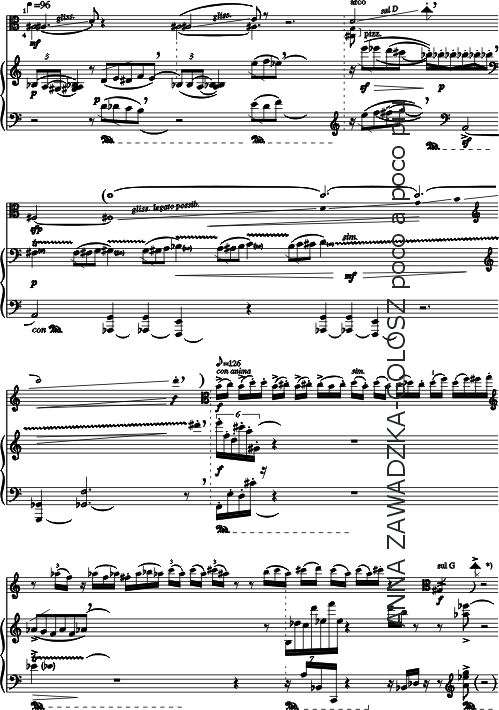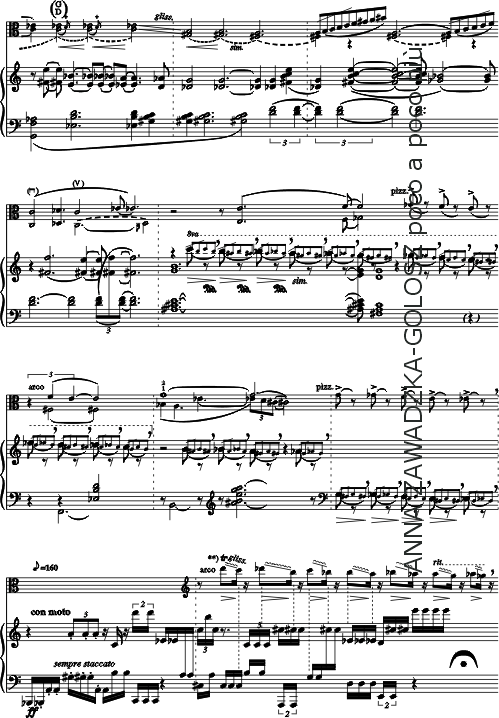ANNA ZAWADZKA-GOLOSZ
POCO A POCO PIÙ...
für Viola und Klavier
- for Viola and Piano
pour Alto et Piano - per
Viola e Pianoforte




Anna Zawadzka hat ihr Studium an der
Hochschule für Musik in Krakau absolviert; im Jahr 1981 die Musiktheorie,
im Jahr 1987 die Komposition bei Frau Professor Krystyna Moszumanska-Nazar.
Während der Studienzeit und nach dem Abschluß arbeitete sie beim experimentellen
Studio des Polnischen Rundfunks in Warschau und beim elektronischen Studio
der Hochschule für Musik in Krakau. In den Jahren 1983, 1984, 1985 und
1986 nahm sie an Internationalen Sommerkursen der jungen Komponisten in
Kazimierz Dolny teil, wo sie u.a. mit Witold Lutoslawski arbeitete. Ihre
Studien hat sie in den Jahren 1986 - 1987 an der Folkwang Hochschule für
Musik, Theater und Tanz in Essen bei Wolfgang Hufschmidt vervollständigt.
Ihre Werke wurden bei allen wichtigsten Musikfestivals für Neue Musik
in Polen - u.a. Warschauer Herbst, Posner Frühling und Festival der Zeitgenössischen
Musik in Breslau - aufgeführt. Ihre Musik wurde in Belgien, Deutschland
(u.a. bei den Tagen der Polnischen Musik in Köln und Stuttgart), Holland,
Frankreich (die Tribune der Komponisten bei der UNESCO) und Rußland vorgetragen.
Die Aufnahmen ihrer Werke befinden sich beim Polnischen, Französchen und
Deutschen Rundfunk. Sie ist Preisträgerin des XXX. Wettbewerbs für junge
Komponisten in Warschau (1988). Seit dem Abschluß ihrer Musikstudien unterrichtet
sie an der Hochschule für Musik/Musikakademie in Krakau.
Anna Zawadzka-Golosz born in Kraków, she studied at the city's
State Higher School of Music (now the Music Academy), gaining the diplomas
in music theory (1981) and composition with Krystyna Moszumanska-Nazar
(1987). She continued her studies with Wolfgang Hufschmidt at the Folkwang
Hochschule für Musik, Theater und Tanz in Essen-Werden (1986-87). She
collaborated for many years with the Experimental Music Studio of Polish
Radio in Warsaw (Girare for percussion and tape was a commission from
the Head of the Studio, Józef Patkowski) and the Electroacoustic Studio
of the Music Academy in Kraków. In 1983-86 she participated in the International
Courses for Young Composers in Kazimierz Dolny in Poland, where she had
a chance to work with Lutoslawski, Xenakis, Szalonek, Shinohara and MCche.
Her chamber, symphonic and electroacoustic pieces have had many performances
in Poland (at all major contemporary music festivals) and abroad (Belgium,
Holland, Finland, Norway, Japan, Germany, France, Russia, Slovakia, Ukraine).
Ever since graduating from the Kraków Academy she has been a member of
its faculty, running a composition class (since 2001) and serving as the
Director of the Institute of Composition, Conducting and Theory at the
Department of Musical Interpretation and Education (since 2005). Selected
works (since 1990): Ornamental Improvisations for two violins, clarinet,
cello, vibraphone and piano (1991), Blades of Grass for percussion (1992),
Rhetorical Figures for three string quartets, strings, oboe, harpsichord
and piano (1993), Poco a poco piE... for viola and piano (1995), Trio
contra punctum for flute, oboe and bassoon (1996), Glissbigliando for
oboe and tape (1997), Mozartkugeln for flute (1998), Mirrors for string
orchestra (1999), Fantasie and chorale for piano (2001), Stained Glass
II for clarinet, cello, vibraphone and accordion, Metaphrases for string
quartet (2001), Cadenza for string quartet (2001), Concerto for Eight-string
Guitar and String Orchestra with piano (2002), Tanvio-lingo-metamorphrases
for violin and piano (2003), Resonance Dances for cello and string quartet
(2005), Tercseptina for piano (2006), The Suite of Space for 17 instruments
(2006). The Suite of Space for 17 instruments was written in 2006; it
was commissioned by the 'Warsaw Autumn' Festival for a specific ensemble
of 11 instruments, which I extended by adding a flute, a double bass and
a number of percussion instruments. In this composition, I decided to
try to realise an idea which I had been considering for some time. It
is my first attempt at conducting a musical narration, of developing the
dramatic content of a composition, in a way which enters into a sound
landscape with an extended spatial dimension. This required the use of
devices which would try to shift perception from the exclusively horizontal
course of events, parallel with the time axis, to the course developing
simultaneously along the axis which is perpendicular to the time line.
Of course it is not possible to escape from the temporal order measured
by clocks, but it is possible to try and enrich this journey by an illusory
spatial dimension and enter into a world of 'musical three dimensions'.
There is an enormous number of problems which arise as soon as the composer
adopts such a strategy; after all, one has to overcome the ingrained perceptual
tendency to follow musical events in a temporal sequence - one after the
other, on a plane of what might be called 'two-dimensional space' of the
musical landscape. Constructing a 'three-dimensional' picture requires
a weakening, and at times even immobilising, of some parameters whose
changeability (such as melody and harmony) runs along the horizontal axis.
In order to direct perception deep into the landscape, these parameters
have to be, in a sense, blocked in time, stopped in their motion, while
other parameters are activated; equivalent devices also have to be found
to retain the link to musical meaning contained in melody, rhythm and
harmony. One of many (probably still hidden) possibilities is to give
autonomy to parameters which at one time were secondary, such as colour,
dynamics or articulation. Treating colour as counterpoint, and dynamics
and articulation as carriers of localisation in the sound plane, symbolising
movement closer to and away from the listener, brings with it, one hopes
(apart from a variety of pitfalls), a chance of opening up perception
to new spatial dimensions. The Suite of Space is separated into small
parts (with and without caesurae), which together constitute a 'space
study' - from the full picture (landscape) to stills and single elements.
Musical narration is constantly accompanied by efforts at enlarging or
diminishing musical 'objects', transposing them, making them move closer
or further away, or penetrate each other; there is a hierarchisation of
elements which appear simultaneously or there are journeys into the depth
of a singular element (what might be called morphologisation) of such
aspects as melody, rhythm or harmony - supported by various unconventional
ways of using instrumentation.
Anna Zawadzka-Golosz
Kompozytorka, urodzona 1 grudnia 1955 w Krakowie. W 1981 ukonczyla
teorie muzyki, a w 1987 - kompozycje w klasie Krystyny Moszumanskiej-Nazar
w Panstwowej Wyzszej Szkole Muzycznej w Krakowie. W latach 1986-87 swoje
umiejetnosci w zakresie kompozycji doskonalila w Folkwang Hochschüle für
Musik, Theater und Tanz w Essen-Werden w Niemczech u Wolfganga Hufschmidta.
Podczas studiów, a takze po ich ukonczeniu, wspólpracowala ze Studiem
Eksperymentalnym Polskiego Radia w Warszawie oraz Studiem Elektronicznym
Akademii Muzycznej w Krakowie, co zaowocowalo twórczoscia w zakresie muzyki
elektroakustycznej. W latach 1983-86 brala udzial w Miedzynarodowych Kursach
dla Mlodych Kompozytorów w Kazimierzu nad Wisla, podczas których miala
okazje wspólpracowac m.in. z Witoldem Lutoslawskim, Iannisem Xenakisem,
Witoldem Szalonkiem, Makoto Shinohara, François-Bernardem Mâchem. Jej
kompozycje wykonywane byly wielokrotnie w kraju, m.in. podczas SLASKICH
DNI MUZYKI WSPÓLCZESNEJ w Katowicach, DNI KOMPOZYTORÓW KRAKOWSKICH, >>>
"WARSZAWSKIEJ JESIENI" oraz za granica (w Belgii, Holandii, Finlandii,
Norwegii, Japonii, Niemczech, Francji, Rosji, na Slowacji i Ukrainie).
Anna Zawadzka-Golosz od ukonczenia studiów pracuje w Akademii Muzycznej
w Krakowie, gdzie obecnie jako adiunkt II stopnia prowadzi klase kompozycji
i wyklada przedmioty teoretyczne.
Fenster schließen
- Close Window - Fermer la fenêtre - Chiudi la finestra